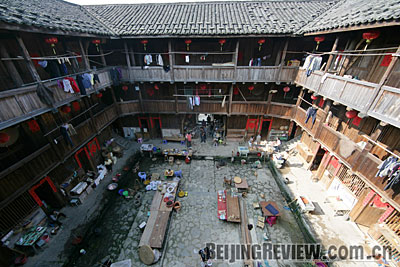|

COMMUNAL LIFE: Tulou residents share a public yard in Bu Yun, one of five Tulous that form the Tianluokeng Tulou Cluster in Nanjing County, Fujian Province (WANG XIANG)
It was 7 a.m., but the scene inside the Tulou building, called Bu Yun, was already a hive of activity. One of 46 Fujian Tulou buildings added to the UNESCO World Heritage List this July, Bu Yun in Nanjing County teemed with activity. Children brushed their teeth, women washed clothes, men set out stalls full of souvenirs and others stood chatting in the local dialect.
Huang Zhixiong, who was born and raised in the three-floor square building, was among the crowd. He has been running a tourist-transportation business for six years, making a living by taking tourists on motorcycle tours of the scattered architecture that dots the hills in the south and west of Fujian Province.
"I was one of the earliest transporters that have been licensed by the local government. I'm not bragging about myself to say that I'm the best and most famous motorcycle driver here," said the 43-year-old, as he ate porridge at a dinning table in the yard. His wife, chatting with another woman nearby, grinned as she heard her husband.
Close community
Bu Yun is one of the five Tulous that form the most famous Tianluokeng Tulou Cluster, an architectural form that consists of one square Tulou in the center, surrounded by a ring of four other round Tulous. The cluster has been given the nickname "four dishes and one soup," because when viewed from the above, it looks like four plates with one square soup bowl in the center.
According to Huang, the residents of all five Tulous are descendants of the same Hakka ancestor who carried the first name Huang. Huang belongs to the 21st generation and the living oldest man in the family, Huang Tianci, belongs to the 18th.
"Different households live together in a Tulou like different members of a family," said Huang. He told Beijing Review that Bu Yun houses 18 households but three of them have moved to other places for work.
"There's little room for privacy living in a Tulou. You open your door and everybody is right there under your nose. Everyone here knows everyone else so well," said Huang, who joked that even bedroom talk between husband and wife can be overheard as the walls of the living room are made of wood that offers poor sound insulation.
When one family has visitors to stay for dinner, their neighbors volunteer whatever the family is short of, be it a piece of meat, some vegetables or rice wine, added Huang's wife.
The intimacy and bonds are not only confined within a single Tulou. To the east of Bu Yun is the round He Chang Tulou, where a bunch of naughty children boldly ran up to hug the strangers' legs and touch their faces.
| 